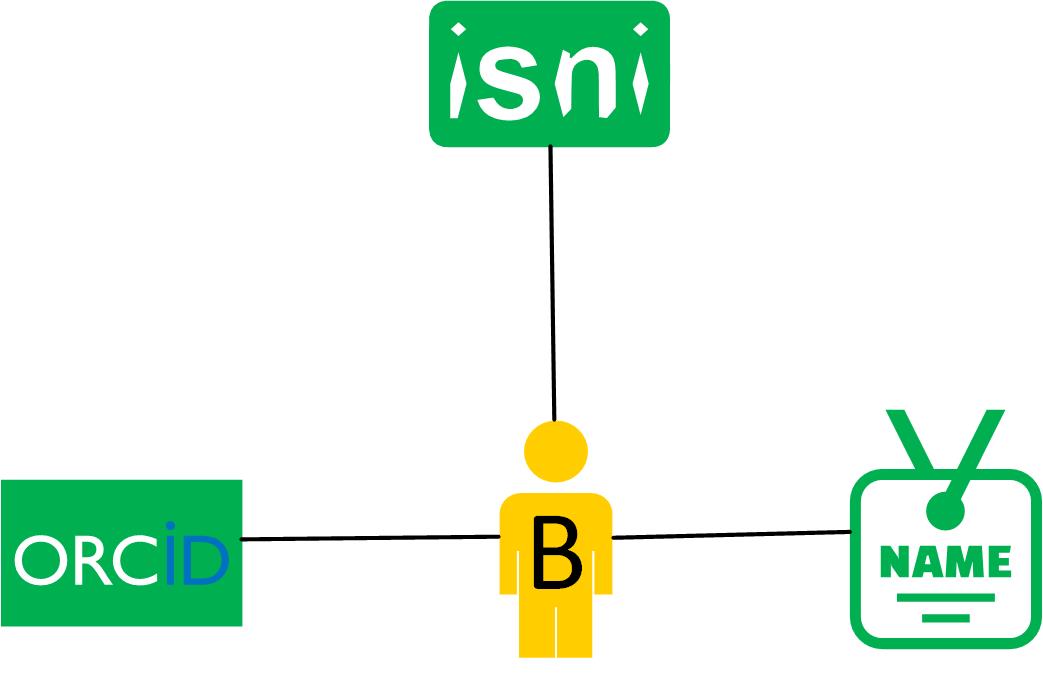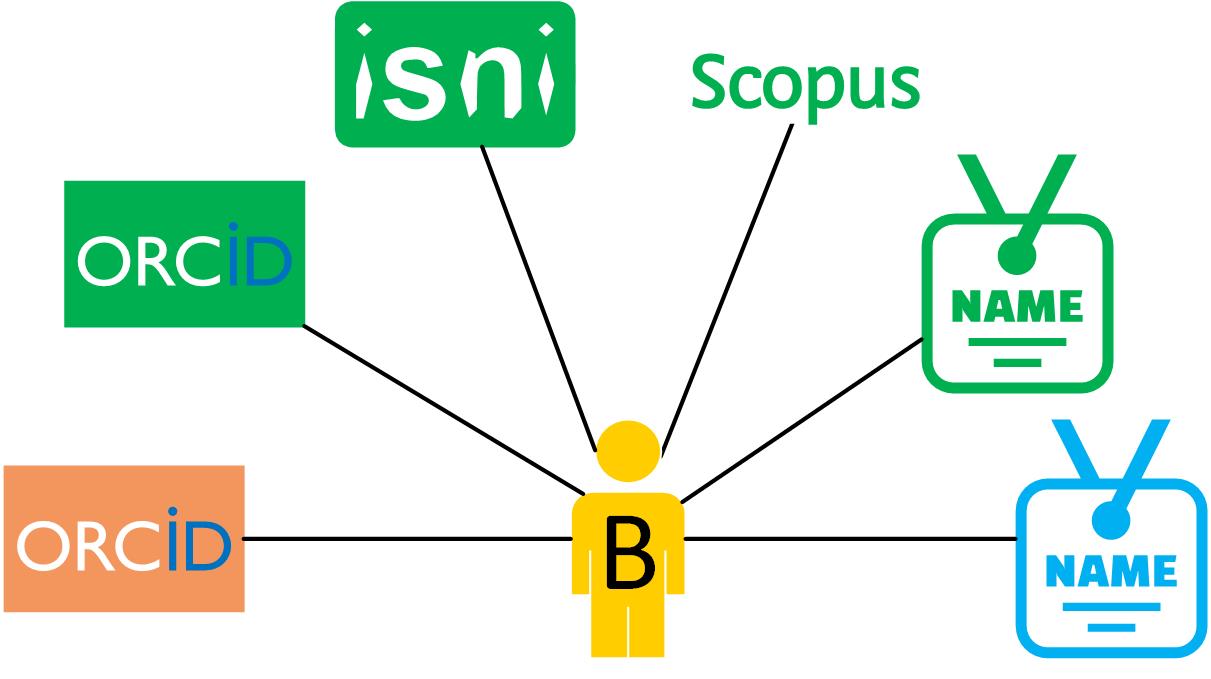Research in context graph, Ricgraph, Ricgraph Explorer, Ricgraph REST API, Data enrichment, Data harvesting, Data linking, Enrichment, Graph, Graph database, Harvest, Harvest data, Harvester, Knowledge graph, Linked data, Metadata, Utrecht University, Visualization
Implementation details
On this page, you can find more information about:
- Person identifiers.
- The Person-root node in Ricgraph.
- Properties of nodes in Ricgraph.
- Conventions for names of (sub-)organizations in Ricgraph.
You can also look at Example research questions.
Return to main README.md file.
1 Person identifiers
In the research world, persons can have any number of different identifiers. Some of these are standard, generally accepted and more-or-less unique identifiers over the lifetime of a person. These are called persistent identifiers. Others are non-unique, some are specific to an organization and some are specific to a company. Examples are:
- persistent identifiers: ORCID, ISNI;
- non-unique identifiers: full name (there are persons with the same name);
- organization identifiers: employee ID, email address (will change when a person leaves an organization);
- company identifiers: Scopus Author ID.
2 Person-root node in Ricgraph
Ricgraph uses a special node person-root. This node is connected to all the different person identifiers which have been harvested. Person-root “represents” a person. Research outputs from a person will also be connected to this person-root node. The following figures shows two examples. B is the person-root node.
| a person with a few identifiers | a person with a lot of identifiers |
|---|---|
 |
 |
A person can have any number of identifiers. The person in the left figure has one ORCID, one ISNI and one FULL_NAME. The person in the right figure has a lot more identifiers, and some identifiers appear more than once. E.g. this person has two different ORCIDs and two FULL_NAMEs (with different spellings).
3 Properties of nodes in Ricgraph
All nodes in Ricgraph have the following properties:
name: name of the node, e.g. ISNI, ORCID, DOI, FULL_NAME, SCOPUS_AUTHOR_ID, etc.;category: category of the node, e.g. person, person-root, book, journal article, data set, software, etc.;value: value of the node;_key: key value of the node, not to be modified by the user;_source: sorted list of sources a record has been harvested from, not to be modified by the user._history: list of history events of the node, not to be modified by the user.
Additional properties for nodes can be added by changing an entry in the Ricgraph initialization file. In the default configuration, the following properties are included:
comment: comment for a node;year: year of a research output;url_main: main URL for a node, pointing to e.g. the corresponding ISNI, ORCID or DOI record on the web;url_other: other URL for a node, pointing to e.g. the originating record in the source system;source_event: an event to be added to_source.history_event: an event to be added to_history.
4 Conventions for names of (sub-)organizations in Ricgraph
In the case that you have harvested sources from multiple organizations, it is useful to adhere to (sub-)organization naming conventions so that you can easily compare them (by searching for the same wordings). However, it is advisable to do this only for those organizations that you have harvested, or that you are specifically interested in, and not for all organizations that your organization relates to, because the latter may be a lot of work.
You can rename organizations after harvesting using the script Rename (sub-)organizations in Ricgraph (rename_organizations).
- Organization abbreviation.
Find the organization in the Research Organization Registry (ROR). This will result in an organization name in a certain language. Create an abbreviation from this name, while respecting the language.
Examples:
ROR organization name organization abbreviation Delft University of Technology DUT Utrecht University UU Vrije Universiteit Amsterdam VUA
- Organization name in Ricgraph.
Combine the organization abbreviation and the ROR organization name.
Examples:
Ricgraph organization name DUT Delft University of Technology UU Utrecht University VUA Vrije Universiteit Amsterdam
- Faculty name in Ricgraph.
Combine the organization abbreviation, the word “Faculty”, a colon (:), and the English name for the faculty as used by the organization (as it is used in Pure).
Examples:
Ricgraph name DUT Faculty: DUT Faculty: Industrial Design Engineering UU Faculty: Geosciences VUA Faculty: Faculty of Science
- Department, Subdepartement, Chair/Subunit, or other sub-organization name in Ricgraph.
Combine the organization abbreviation, one of the words in this list [“Department”, “Subdepartment”, “Chair/Subunit”, “Unit”, “Research Institute”, “Research Group”] (or similar word), a colon (:), and the English name for the sub-organization as used by the organization (as it is used in Pure).
Examples:
Ricgraph name DUT Department: Biomechanical Engineering DUT Research Group: Physical and Space Geodesy UU Department: Dep Psychologie UU Chair/Subunit: LS Taal en cultuurstudies VUA Department: Earth Sciences VUA Subdepartment: Chemistry and Biology VUA Research Institute: Amsterdam Neuroscience
- Hierarchy name in Ricgraph. This is a kind of meta category.
Combine the organization abbreviation, the word “Hierarchy”, a colon (:), and the English name for the hierarchy as used by the organization (as it is used in Pure).
Examples:
Ricgraph name UU Hierarchy: Faculties UU Hierarchy: University Corporate Offices VUA Hierarchy: Faculties VUA Hierarchy: Research Institutes
- Services (support) organization name in Ricgraph.
Combine the organization abbreviation, the word “Services”, a colon (:), and the English name for the sub-organization as used by the organization (as it is used in Pure).
Examples:
Ricgraph name UU Services: University Library VUA Services: University Library












